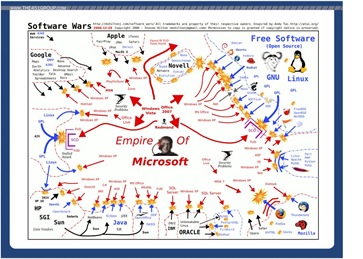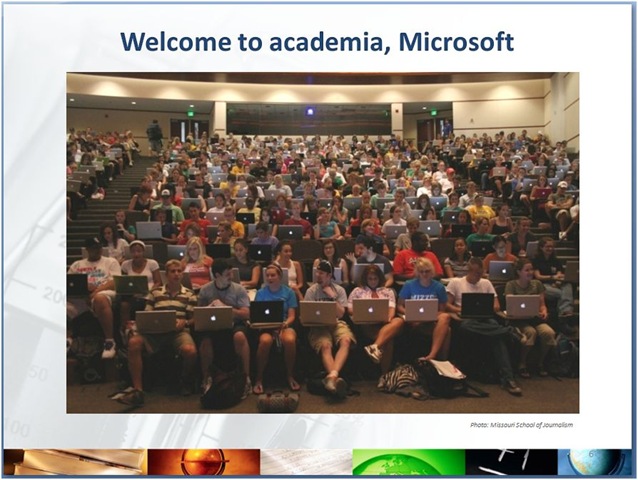Putting our own House in Order….
by MJM on April 04, 2008 04:34pm
Jamie blogged about Open Source Day earlier this week. I’d like to provide a little more context about what the day was and why we did it.
About 6 months ago, our team was discussing the fact that, while many external people understand what Microsoft is trying to do in the open source space, many folks inside Microsoft still aren't fully aware. As a result, we continuously discover people across Microsoft who are interested in (or working on) ways for their product or program and open source to grow together but believe they have to 'go it alone.'
To help those folks, we decided to put together an informational event to explain to key segments of our internal community what the company is doing with open source and why. Little did we know that what was originally expected to be a 2-3 hour discussion in a conference room with a few people would turn into a full-day event with 12 presenters, a 400-person, full multi-media presentation hall and one heck of a catering bill.
When I first announced our intent to inform employees about Microsoft’s source code strategy, I received an amazing response. Although my team spends its days thinking about how Microsoft participate in the open source communities, we sometimes forget how many parts of the company touch on open source issues. From product groups to marketing groups to our legal division, it seems like everyone has questions or ideas about how Microsoft should engage with open source.
Ultimately, since this was our first internal event, we decided to go with the 30,000’ view and bring in a series of speakers to talk about what we’re doing with source code and why we’re doing it. We left a lot of details to later discussions. The point of the day was to get employees thinking and talking about open source in new and challenging ways.
To make sure the day wasn’t a Microsoft echo chamber, we invited Raven Zachary from the 451 Group to provide external context for our discussion. He got the day off to a stimulating start by providing an entertaining and informative overview of the business of OSS and how Microsoft fits in. While Raven pointed out some of the good things we’re doing, he focused particularly on what we’re not doing so well and how we can do better. He also provided the audience with some great insight into how Microsoft is viewed by many in the OSS community. He showed one slide in particular that really made me think:

This is a map from a site that is regularly updated to reflect how the “software wars” against Microsoft are progressing. I think the image is great, and not just because it’s entertaining. It reminds me that everything we do as a company is being watched and analyzed by smart and insightful -- even if sometimes a bit obsessive :) --- people. That means we have to do “real” things, and we have to be transparent about why we’re doing them. That doesn’t mean that everything we do has to please everyone; that will never happen. We just have to be sure there’s a reason for what we do and we that we share that reason openly and frankly.
After Raven set the stage, the audience heard from a number of folks including Sam Ramji, the Sr. Director of Platform Strategy, and Bryan Kirschner, the Director of Community Strategy who explained our open source strategy from a business and community perspective respectively.
Probably the most provocative of the morning’s keynote speakers was Tony Hey, the Corporate VP of External Research. Tony’s background is in academia, a place where Microsoft has had some challenges (as this slide from his presentation vividly illustrates):

Tony gave an inspirational talk about how Microsoft should be willing to work with open source in the academic arena. Tony is a straight shooter, and he emphasized that, when you strip away the ideology and propaganda, our goal is to provide the best experience for our customers. To do that requires flexibility in how we approach software development and licensing. As a company, we should expand our horizons and harness the best of all the various approaches to create the most efficient solutions to academics’ technological challenges.
The rest of the day involved talks by various groups who participate in code sharing at Microsoft, including the Shared Source Program and CodePlex (before anyone complains, neither of those groups were billed as purely “open source,” although there are certainly open source aspects to both.) We also discussed OSS legal issues and had a couple of panels involving folks here at Microsoft who work on open source projects or programs, including Rob Mensching, the developer of WiX, John Lam, the developer of IronRuby, Shawn Burke, the developer of the ASP.NET AJAX Control Toolkit and Tom Hanrahan, the director of the Microsoft-Novell Interoperability Lab in Cambridge, Mass.
At the end of the day, we had a reception for the hardy souls who stuck around through the snow. I was very pleasantly surprised by the reaction of the audience throughout the day and at the reception. There were tough questions and great stories from across the company. We knew there was a lot of interest in the company regarding open source, but we were surprised by the depth and breadth of that interest. This bodes well for the company because that interest will drive more and more open source activity inside and outside the company as we move forward. Who knows, maybe we’ll get Steve Ballmer to talk at Open Source Day 2009.